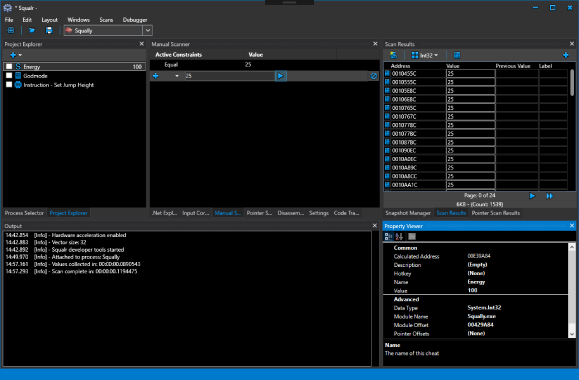Squalr is performant Memory Editing software that allows users to create and share cheats in their windows desktop games. This includes memory scanning, pointers, x86/x64 assembly injection, and so on.
Squalr achieves fast scans through multi-threading combined with SIMD instructions. See this article: SIMD in .NET. To take advantage of these gains, your CPU needs to have support for SSE, AVX, or AVX-512.
Documentation
You can find detailed documentation on the Wiki. There are three ways to use Squalr:
- Front end GUI
- Scripting API
- Back end NuGet packages
Below is some brief documentation on the NuGet package APIs
Receiving Engine Output
If using the NuGet packages, it is important to hook into the engine’s output to receive logs of events. These are invaluable for diagnosing issues.
using Squalr.Engine.Logging;
…
// Receive logs from the engine
Logger.Subscribe(new EngineLogEvents());
…
class EngineLogEvents : ILoggerObserver
{
public void OnLogEvent(LogLevel logLevel, string message, string innerMessage)
{
Console.WriteLine(message);
Console.WriteLine(innerMessage);
}
}
Attaching The Engine
using Squalr.Engine.OS;
…
IEnumerable processes = Processes.Default.GetProcesses();
// Pick a process. For this example, we are just grabbing the first one.
Process process = processes.FirstOrDefault();
Processes.Default.OpenedProcess = process;
Manipulating Memory
using Squalr.Engine.Memory;
…
Reader.Default.Read(address);
Writer.Default.Write(address);
Allocator.Alloc(address, 256);
IEnumerable regions = Query.GetVirtualPages(requiredProtection, excludedProtection, allowedTypes, startAddress, endAddress);
IEnumerable modules = Query.GetModules();
Assembling/Disassembling
Squalr can assemble and disassemble x86/x64 instructions, leveraging NASM.
using Squalr.Engine.Architecture;
using Squalr.Engine.Architecture.Assemblers;
…
// Perform assembly
AssemblerResult result = Assembler.Default.Assemble(assembly: “mov eax, 5”, isProcess32Bit: true, baseAddress: 0x10000);
Console.WriteLine(BitConverter.ToString(result.Bytes).Replace(“-“, ” “));
// Disassemble the result (we will get the same instructions back)
Instruction[] instructions = Disassembler.Default.Disassemble(bytes: result.Bytes, isProcess32Bit: true, baseAddress: 0x10000);
Console.WriteLine(instructions[0].Mnemonic);
Scanning
Squalr has an API for performing high performance memory scanning:
using Squalr.Engine.Scanning;
using Squalr.Engine.Scanning.Scanners;
using Squalr.Engine.Scanning.Scanners.Constraints;
using Squalr.Engine.Scanning.Snapshots;
…
DataType dataType = DataType.Int32;
// Collect values
TrackableTask valueCollectorTask = ValueCollector.CollectValues(
SnapshotManager.GetSnapshot(Snapshot.SnapshotRetrievalMode.FromActiveSnapshotOrPrefilter, dataType));
// Perform manual scan on value collection complete
valueCollectorTask.CompletedCallback += ((completedValueCollection) =>
{
Snapshot snapshot = completedValueCollection.Result;
// Constraints
ScanConstraintCollection scanConstraints = new ScanConstraintCollection();
scanConstraints.AddConstraint(new ScanConstraint(ScanConstraint.ConstraintType.Equal, 25));
TrackableTask scanTask = ManualScanner.Scan(
snapshot,
allScanConstraints);
SnapshotManager.SaveSnapshot(scanTask.Result);
});
for (UInt64 index = 0; index < snapshot.ElementCount; index++)
{
SnapshotElementIndexer element = snapshot[index];
Object currentValue = element.HasCurrentValue() ? element.LoadCurrentValue() : null;
Object previousValue = element.HasPreviousValue() ? element.LoadPreviousValue() : null;
}
Debugging
// Example: Tracing write events on a float
BreakpointSize size = Debugger.Default.SizeToBreakpointSize(sizeof(float));
CancellationTokenSource cancellationTokenSource = Debugger.Default.FindWhatWrites(0x10000, size, this.CodeTraceEvent);
…
// When finished, cancel the instruction collection
cancellationTokenSource.cancel();
…
private void CodeTraceEvent(CodeTraceInfo codeTraceInfo)
{
Console.WriteLine(codeTraceInfo.Instruction.Address.ToString(“X”));
Console.WriteLine(codeTraceInfo.Instruction.Mnemonic);
}
Recommended Visual Studio Extensions
| Reference | Description |
|---|---|
| XAML Formatter | XAML should be run through this formatter |
| StyleCop | StyleCop to enforce code conventions. Note that we deviate on some standard conventions. We use the full type name for variables (ex Int32 rather than int). The reasoning is that this is a memory editor, so we prefer to use the type name that is most explicit to avoid coding mistakes. |
Build
In order to compile Squalr, you should only need Visual Studio 2017. This should be up to date, we frequently update Squalr to use the latest version of the .NET framework. Here are the important 3rd party libraries that this project uses:
| Library | Description |
|---|---|
| EasyHook | Managed/Unmanaged API Hooking |
| SharpDisasm | Udis86 Assembler Ported to C# |
| CsScript | C# Scripting Library |
| AvalonEdit | Code Editing Library |
| SharpDX | DirectX Wrapper |
| CLRMD | .NET Application Inspection Library |
| AvalonDock | Docking Library |
| LiveCharts | WPF Charts |
Planned Features
| Library | Description | Purpose |
|---|---|---|
| AsmJit | x86/x64 Assembler | Replace FASM, improve scripting drastically |
| AsmJit | x86/x64 Assembler | Original C++ project. May port/interop this if the above version does not work (Neither may fully work, and something custom may be needed) |
| WpfHexEditorControl | Hex Editor | Hex editor / Memory Hex Editor |
| OpenTK | OpenGL Wrapper | Graphics Injection |
| SharpDX | DirectX Wrapper | Graphics Injection (Currently using SharpDX just for input) |
| SharpPCap | Packet Capture | Packet Editor |
| Packet.Net | Packet Capture | Packet Editor |









